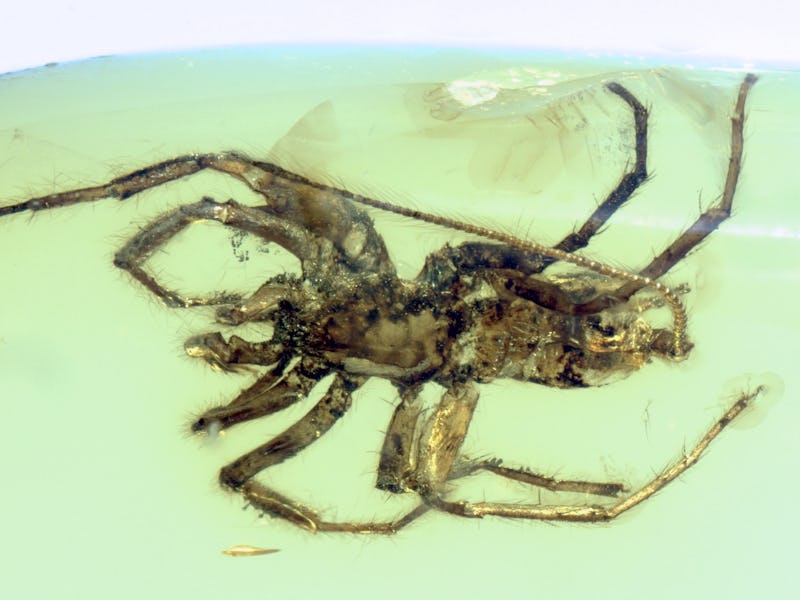Terrifying Dinosaur-Age Fossils Resemble Fanged Spiders With Tails
Scientists don't know what they actually are.

On Monday, two teams of scientists reported the discovery of 100-million-year-old arachnid fossils, found preserved in Burmese amber. To the naked eye, each of these four specimens look like a cross between a spider and a scorpion, sporting silk-spinning organs, a long tail-like appendage called a telson, and fangs. Making sense of this creature, known as Chimerachne yingi, is proving to be a challenge for the scientists, who can’t seem to agree where to place it on the evolutionary tree.
The different arguments are laid out in separate papers in Nature Ecology and Evolution. One analysis, led by Gonzalo Gribbet, Ph.D., of Harvard University, claims that C. yingi belongs within an extinct order of arachnids called the Urarneida. In the competing paper, scientists led by Bo Wang, Ph.D., of the Chinese Academy of Science, argue that C. yingi may be “one of the first true spiders”, placing it within the order Aranea — or it could belong to a completely separate branch of arachnids.
Photo of the holotype of C. yingi, dorsal view.
The “extraordinarily well-preserved” specimens were first discovered in amber markets in Myanmar, which is not so far from the Southeast Asian rainforests where the creatures are thought to have lived. Greg Edgecombe, Ph.D., an invertebrate paleobiologist not affiliated with either study, told the New York Times earlier this month that these specimens have “a combination of characteristics that initially seems alien to an arachnologist.”
Described by Wang’s team as a 2.5-millimeter-long creature that “essentially resembles a spider with a tail”, the C. yingi, like modern spiders, had prominent multi-articulated spinnerets with well-defined spigots. The existence of these spinnerets, the organs that excrete silk in precise patterns, casts doubt on whether this ancient arachnid was a member of the Uraraneida, which usually have spigots but no spinnerets.
“Our new fossil most likely represents the earliest branch of the Aranea and implies that there was a lineage of tailed spiders that presumably originated the Palaeozoic and survived at least into the Cretaceous of Southeast Asia,” the team writes.
Photo of the paratype of C. yingi, ventral view.
Meanwhile, Gribbet’s team argues that the presence of spigots along a long tail, which was likely used as a sensory organ, puts these arachnids in a different group known as the Urareneida.
“The phylogenetic placement of this arachnid fossil extends the presence of spinnerets and modified palps [appendages that deliver sperm] more basally in the arachnid tree than was previously thought,” they write. “Ecologically, the new fossil extends the record of Urarenida 170 million years toward the present, thus showing that uraraneids and spiders co-existed for a large fraction of their evolutionary history.”
While there’s still no consensus on what exactly this critter is, it’s still an exciting step toward understanding the history of spiders. Millions of spiders have lived on Earth for millions of years, but their origins are still obscure. The scientists can agree that the new C. yingi specimens document a key stage of spider evolution — they just have to decide exactly what that stage is.